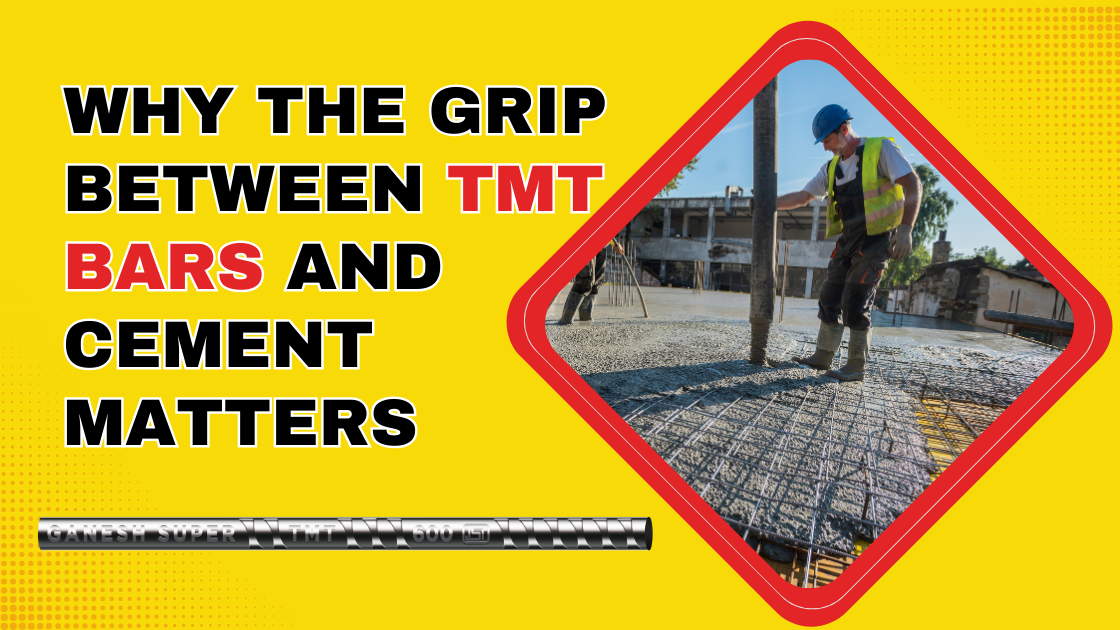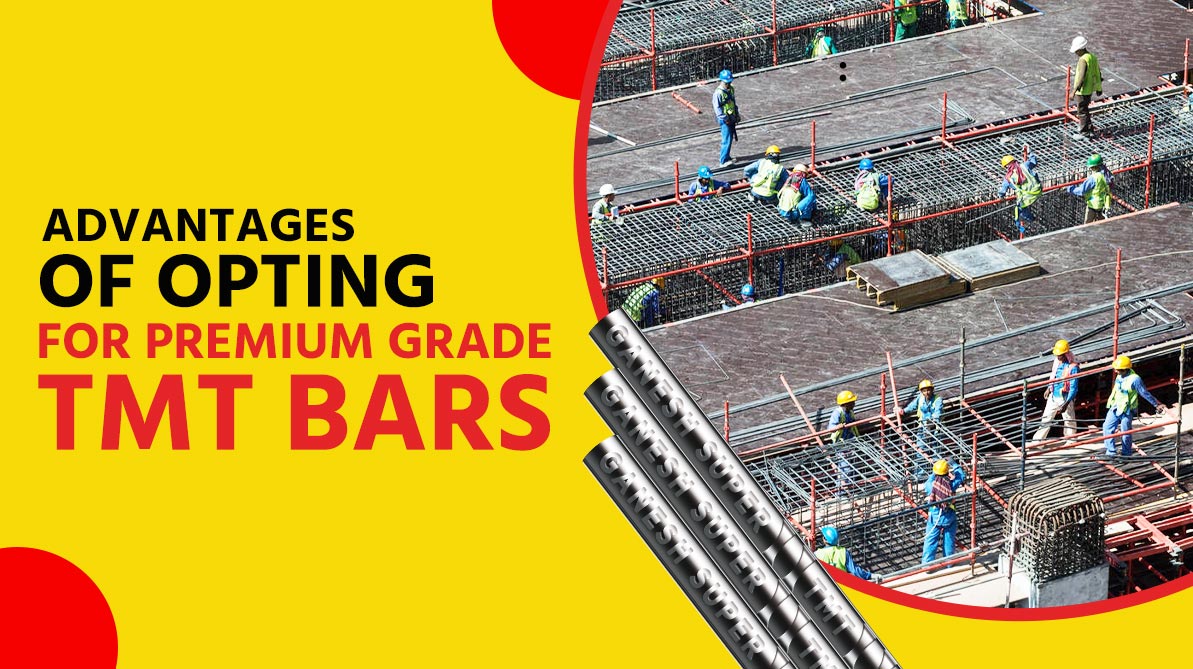In the construction industry, every detail contributes to the integrity and longevity of a structure. These qualities have become the foundation of millions of homes and buildings that are built, lives are sheltered, and progress thrives. But what holds this network of concrete and steel together? The answer lies in the unseen alliance between TMT bars and cement. Their grip, often overlooked and underestimated, is the unsung hero of every sturdy structure. They ensure the structural stability and safety of buildings, bridges, and infrastructure projects. In this blog, you will know why the grip between TMT bars and cement matters and its contribution towards construction quality and safety.
Understanding the Grip
The grip between TMT bars and cement refers to the adhesion or bond strength between the two materials within a reinforced concrete structure. When concrete is poured around TMT bars during construction, it undergoes a curing process. During this process, the cement hardens and forms a strong bond with the surface of the bars. This bond is essential for transferring loads between the steel reinforcement and surrounding concrete. This increases the structural integrity of the entire construction project.
Beyond Mere Stickiness
The connection between TMT bars and cement is not like that of glue and any surface. Their interaction is meticulously designed and is fueled by a combination of physical and chemical forces. The ribbed surface of TMT bars creates a larger surface area for the cement to grip, which enhances the chemical bond. Additionally, the chemical composition of cement allows it to hydrate, which reacts with the steel and forms a microcrystalline structure that further strengthens the bond.
Beyond Strength
The strong grip between TMT bars and cement rises above mere structural stability. It plays a crucial role in resisting earthquakes. TMT bar manufacturers make steel bars that will absorb and distribute the forces while the cement fills the gaps and prevents cracks. This ensures the structure’s integrity, potentially saving lives and protecting valuable assets.
Importance in Structural Stability
Load Transfer
One of the primary functions of TMT bars in reinforced concrete structures is to withstand tensile forces. Concrete is excellent in compression but weak in tension. Therefore, TMT bars are strategically placed within chambers of concrete to resist tensile stresses. The effectiveness of this arrangement depends heavily on the bond strength between the bars and the surrounding concrete. When loads are applied to a structure, whether from gravity, wind, or seismic forces, they are transferred between the concrete and the embedded TMT bars. A strong bond ensures efficient load transfer, which allows the concrete and steel to work together to resist bending, shear, and other structural forces. If the bond is weak, the transfer of loads between the two materials may be compromised, leading to localised failures, such as cracks or delamination between the concrete and the bars.
Resistance to Corrosion
In reinforced concrete structures, the steel reinforcement is vulnerable to corrosion when exposed to moisture, oxygen, and other corrosive agents. A strong bond between TMT bars and concrete plays a crucial role in protecting the steel from corrosion. When moisture pierces through the concrete cover, it can reach the embedded TMT bars. However, if the bond between the bars and the surrounding concrete is strong, it forms a barrier that prevents the entrance of moisture and other corrosive agents. This barrier effectively shields the steel reinforcement, prolonging its serviceable life and maintaining the structural integrity of the concrete.
Flexural Strength
The bond between TMT bars and concrete is essential for increasing the flexibility and ductility of constructed elements such as beams, slabs, and columns. For example, when a load is applied to a beam, the side with tension elongates while the compressed side constricts. The TMT bars on the tension side resist the tensile forces, while the concrete on the other side bears the compressive forces. A strong bond between the bars and concrete ensures effective load transfer across the critical interface. This prevents premature failure due to debonding or slippage of reinforcement.
Factors Influencing The Grip
Surface condition of TMT Bars
The surface of TMT bars must be free from rust, mill scale, grease, or any other contaminants. These elements could prevent the steel bars from bonding with the concrete. Proper cleaning and surface preparation are essential to ensure adhesion that will not break under rigorous conditions.
Quality of Concrete Mix
The composition and quality of the concrete mix can significantly impact the bond strength between the cement and TMT bar. Different factors, such as water-cement ratio, aggregate grading, curing methods and admixtures, play crucial roles in determining the final bond between the concrete and TMT bars.
Embedment Length
The length of the bars set in the concrete influences the bond strength. The proper length ensures sufficient surface area for bonding and prevents slippage or dislocation of reinforcement under load.
Construction Practices
Proper construction techniques are essential for achieving optimal bond strength. It includes adequate concrete around the TMT bars so that it is compact, has proper placement and spacing of reinforcement, and follows the recommended curing procedures.
Benefits of Proper Grip
Enhanced Durability
The strong grip between concrete and TMT bars creates a physical barrier that prevents water and oxygen from reaching the cars. This minimises corrosion and extends the lifespan of the structure. It also protects the steel from harsh weather conditions, prevents premature deterioration and ensures long-lasting performance.
Fire Resistance
Cement acts as a heat shield that protects the steel bars from the intense heat of fire. This delays the loss of structural strength and allows for more time for the occupants to evacuate. TMT saria manufacturers also ensure that the bars follow the stringent fire safety codes that are essential for the TMT & cement bond for fire-resistant structures. Always choose high-quality TMT bars and ensure proper bonding that contributes to fulfiling these codes and increasing the overall safety of the blogs.
Prevent Sound & Water
The bond between TMT bars and cement creates a denser structure. This improves its sound insulation properties. This is particularly important for residential and commercial buildings and promotes a quieter and more comfortable living environment. The grip also plays a huge role in minimising the risk of water infiltration. It protects the steel from corrosion and prevents leaks within the structure. This ensures the functionality and longevity of the building while creating a healthy indoor environment.
The Bottom Line
The grip between the TMT bars and concrete is more than just a technical marvel. It is the testament of combining elements of different to achieve a common goal, that is, building a secure and resilient future. It ensures a strong bond that is achieved through the careful selection of materials, construction practices and quality control measures. This empowers TMT saria manufacturers to contribute to a future where structures are not only strong and resilient but also sustainable and contribute to a healthy and safe living environment for generations to come.





